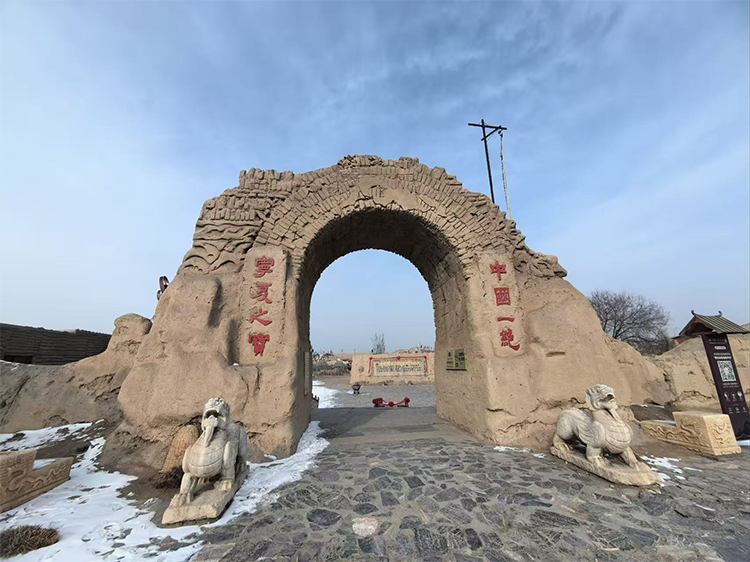Zhenbeibao Desert Fortress: Explore Ningxia’s “Oriental Hollywood” Film City
Introduction:
When the hero of A Chinese Odyssey stands on the earthen wall and utters that unforgettable line, or when the distillery in Red Sorghum spills its fiery red at sunset, Zhenbeibao Western Film City in Yinchuan, Ningxia, becomes more than a shooting location. It is an open-air museum built from yellow loess, light, and tales of rivers-and-lakes. Here the vastness of Northwest China collides with cinematic romance; beneath the rammed-earth walls of Ming and Qing military outposts lie countless youthful memories. Walking these streets feels half like the sweeping grandeur of a desert landscape, half like a tender love scene.
1. Desert Aesthetics and a Movie Sanctuary
“A film memory vault in an ancient loess city” sums up Zhenbeibao’s unique charm. As a cradle for western-genre Chinese cinema, the film city uses authentic northwest terrain and reconstructed Ming-Qing military sites as its foundation. More than 200 films and TV shows, including New Dragon Gate Inn and The Herdsman, were shot here. The rough earthen walls, leaning wooden flagpoles, and weathered tavern signs all read like sets intentionally aged by time; a casual photo feels like a still from a major production.
2. A Century-Spanning Architectural Stage
· Ming Fortress and Qing City: Two earthen fortifications rebuilt on Ming-era border defense prototypes form the backbone of the park. The Ming fortress still shows its defensive wisdom with features like a sally port and soldier shelters; the Qing city recreates courier houses, pawnshops, and stables that restore the bustling atmosphere of an ancient frontier trade town.
· Old Yinchuan Street: A 1:1 replica of 1940s Yinchuan, complete with apothecary cabinets, tea-house tables, and vintage movie posters from the former Great Bright Cinema. Every detail carries a sense of era authenticity.
· Must-See Filming Spots: Fans can seek the bar where the hero confesses in A Chinese Odyssey, the moon gate leading to the Spider Cave, and the distillery on Eighteen-Li Slope from Red Sorghum — each corner offers a moment of cinematic nostalgia.
3. Immersive Experiences: From Bystander to On-Screen Character
· Living Intangible Heritage Shows: Daily shadow-puppet theater, Helan Mountain petroglyph rubbings, and Ningxia flower-song performances bring static sets to life. Visitors can try their hand behind the shadow-puppet stage and perform a short scene of The Three Battles with the White Bone Demon.
· Costume Time-Travel: Rental costumes of classic characters such as Zixia Fairy, the hero, and caravan guards are available. Wearing period garb and recreating production photos is a favored interactive activity among young travelers.
· Military Easter Eggs: Practice archery at the Ming fortress range and feel like a fortress defender, or solve escape-room puzzles in the Qing courier house to unlock hidden storylines.

4. On-Set Flavors: Northwest Cuisine with a Filmmaker Twist
· Cast-and-Crew Dishes: Taste the Eighteen-Li Red sorghum wine (often substituted with goji berry wine for visitors) and try roast whole lamb like that served during filming of period epics. Even the food carries a theatrical quality.
· Old Yinchuan Flavors: Stall owners selling hand-held mutton will teach you the local garlic-dip method; long lines form for spicy millet porridge and aiweed noodles, full of market-life flavor.
· Dining in a Set: Eat a bowl of lamb-noodle stew in a Shanxi merchant courtyard used for scenes in Qiao Family Courtyard productions, and it feels like you have stepped into the drama.
5. Local Insider Tips
· Best Times: Arrive at 8:00 a.m. or 5:00 p.m. to avoid tour groups and enjoy the most beautiful light on the walls.
· Hidden Photo Spots: The northwest corner of the Qing city, called the “Broken-Heart Cliff” platform, captures Helan Mountain and the earthen walls together. The second floor of the Fushunchang fabric shop on Old Yinchuan Street is a secret spot for overhead street shots.
· Avoid These Traps: Many “film replica” fur capes sold outside the park are synthetic. Choose handcrafted genuine sheepskin items from the park’s intangible-heritage shops for authenticity and quality.
6. Practical Information Box
Location: Zhenbeibao Town, Xixia District, Yinchuan — about 25 km from downtown
Opening Hours: 8:00–18:00 (extended to 19:00 in peak season)
Cost: Admission 80 RMB, basic scenes included; costume rentals 50–100 RMB per set
Transport: Tourist shuttle line “You-1” goes directly; drive and navigate to “Zhenbeibao Western Film City East Parking”
Tips: Wi‑Fi covers most of the park; key venues have English signage and some staff speak basic English. Carry cash for remote stalls.

Conclusion:
At Zhenbeibao, film is no longer a flickering dream behind glass — it is touchable, playable, and edible. When the Helan Mountain wind sighs through the wall cracks like a cinematic score, you realize the most moving thing here is not the replicated set, but that everyone can find a personal leading-role moment. Leave at least one day in your northwest itinerary for this loess-land drama playground.


